|
Fancy Weavers
of the Finger Lakes
by
Anne Brewer
At a workshop presented by Rabbit Goody, Clarita Anderson. Diane Fagan Affleck
and others in September 1986 at the Farmers Museum in Cooperstown, New York,
we participants were challenged to find professional weavers of the 1830s to
1860s when we returned home. This compilation is the result of my research
in the Finger Lakes Region where I lived from 1970 to 1997.
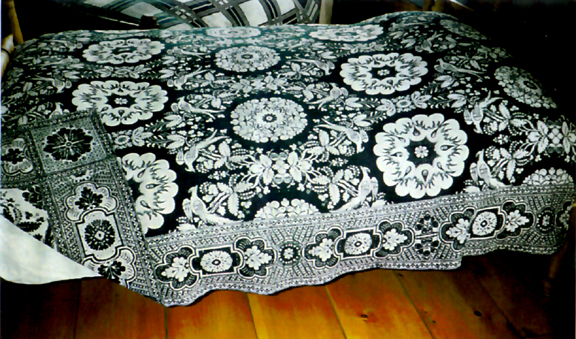
Coverlet in the Patterson Inn, Corning, NY. May have been woven by the
Auburn Prison Weavers.
Gift of Mrs. Robert Dann. Photo by Anne
Brewer, 1993
My findings included coverlets, printed advertisements of weavers in old newspapers, references to weavers in area histories, family accounts, tombstone inscriptions, and references in genealogies and in vital records. I have not included all the family information that I have of the weavers such as census records, wills, deeds.
In my earlier article, Finger
Lakes Weavers; Makers of Fancy Coverlets,
in the July 1995 issue of the Crooked Lake Review, I wrote of James
Van Ness and Ira Hadsell, two weavers in the Palmyra vicinity and of the LaTourette
family who lived in Tyrone and Hector.
Fancy weaving refers to fabrics, usually to coverlets, with intricate designs.
The looms that could produce such designs had either a Jacquard attachment
with punched cards that controlled the position of each warp thread to form
the pattern, or a cylinder studded with pegs that controlled the location of
each warp thread for every woof thread added. Looms so equipped were intricate
and required intelligence and experience to operate. Usually these skills were
learned by apprentices, as children or close relatives and were passed on in
families.
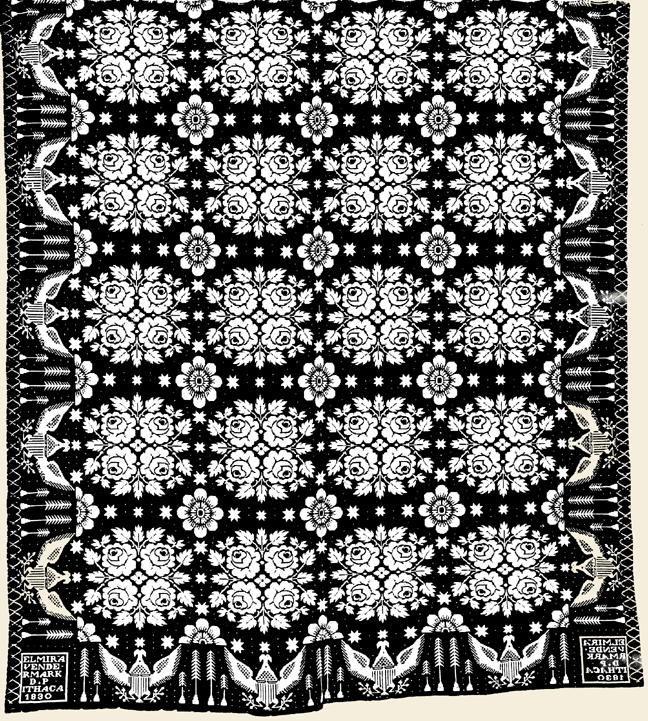
Coverlet woven by D.P., Ithaca, NY 1830. Probably by David Pollay. Illustration
from Peter Jensen.
Many pioneer families had looms for weaving suiting, blankets and carpeting.
When these looms had four frames carrying heddles with warp threads strung
through them, they could produce both plain weave and twill weave, which is
more suitable for clothing because it conforms more closely to a wearers body.
These looms could also produce simple geometric patterns for coverlets
and table cloths.
One history of Seneca County-states that Ovid township, about 10 miles square, had 6 grain mills, 7 saw mills,3 fulling mills, 2 carding machines, 9 distilleries, 4 potash works and 3 tanneries. “There are also 167 looms in families which produced 56,447 yards of cloth in 1810.”
The 1876 History of Seneca County published by Everts and Ensign
reports that “In 1804, Paul Goltry, in a log house, the first in present Lodi,
manufactured looms, fanning mills and other articles. He jealousy guarded the
secret of
weaving “riddles’ for his mills, and his workshop was forbidden to his family.
The mills had no castings, and would be a curiosity now.”
The following advertisement appeared in the Steuben Farmers Advocate, Bath.
Fancy Spread Weaving
PAUL G. GOLTRY has removed from his old stand, in Reading, and commenced
the above business in the town of Orange, two miles north of Gaylord’s, Meads
Creek. Having furnished himself with a new and splendid machine, he is prepared
to
do all work entrusted to him in the neatest and most durable manner.
Directions. Cotton yarn should be either No. 7 or 8, two threads. Wool
should be spun 38 knots to the pound and left single. Prepare eight runs
of each for
a spread.
N. B. Yarn will be taken at Garret Glawson’s, Hector, and at the old stand
Reading; and spreads returned.
Orange, May 30 1838.
A similar advertisement appeared Oct. 19, 1839:
FANCY SPREAD WEAVING. The subscriber, would respectfully inform the citizens
of Steuben co. that he still continues the business of Weaving as usual,
two miles north of Gaylord’s, where he will do work appertaining to his line
of business with dispatch, and in a workmanlike manner.
PAUL W. GOLTRY [note changed middle initial]
A final trace of Paul Goltry in deed records of 1845 finds that he and his wife Deborah are in Dodge County, Wisconsin.
The following advertisement of Jonathan Conger of Groton, NY, appeared in
the Jan. 20, 1830 Ithaca Journal:
WEAVING AND DYING
The subscriber respectfully informs the publick, that he has recently made
great improvements in his machinery and other conveniences, and is now prepared
to conduct the business of Weaving and Dying in their greatest varieties
and in the present styles at his residence in the town of Groton, Tompkins
county, one mile north of the Bensonville Post Office, and two miles south
of Brinkeshoff’s store.
CARPETINGS died and wove in all the latest European colours and patterns.
Carpet COVERLETS wove with the owner’s names, date of the month and year, &c.
and with a rich Spread Eagle Border. Also all other kinds of plain and ornamental
Weaving and Dying usually done in this country. Terms will be reasonable,
and all orders promptly and punctually attended to.
N. B. Yarn spun for Carpeting, two runs in a pound doubled and twisted. If single, one run in a pound.
JONATHAN CONGER.
Directly below in the column was another weaver’s advertisement:
DAVID POLLAY & Co. Fancy Weavers and Dyers, (at the shop
of James Raymond, near Bennett’s Mills,) takes this opportunity to inform
their friends and the publick generally, that they have made new and important
alterations
in their Weaving Establishment. They are now putting into operation a PATENT
LOOM which will enable them to weave CARPETS [in] any figure that can be
wove either in Europe or America. (provided the yarn is properly died.) They
can also Weave Coverlets any figure that can be wove in the ”United States.” Also,
Diapers, Kerseys &c.
in as good a style as elsewhere, and on shortest notice.
For the accommodation of those who wish to have Carpets wove, they will
die the yarn suitable to make the figure wanted on reasonable terms. Among
the colours they make are blue, red, crimson, scarlet red, green, orange,
yellow, buffs &c. They solicit a share of patronage.
Most kinds of Country Produce received at market prices.
Ithaca, Nov. 10, 1829.
The proximity of these two advertisements suggest a connection between
Jonathan Conger and David Pollay and in fact they were half brothers. Their
mother was Phoebe Johnson. Her
first husband was Jacob Conger, with whom she had at least eight children including
Jonathan Conger (born 1801). Her second husband was Uriah Pollay, with whom
she had at least two children including David Pollay
(born
1806).
Jonathan Conger taught David Pollay to weave. Jonathan worked for many
years
in
Groton
on loom
improvements. David moved to Ithaca where he advertised himself as a fancy
weaver. He married Sally Ann Eaton, then moved to Southport, near Elmira, where
he did weaving for a time but turned to carpentry. John Conger (J. Conger)
was a nephew of Jonathan Conger and did fancy weaving in Southport. Apparently
they both moved about 1842 or 1843: John to Livonia, N.Y. and David to Hammondsport,
N.Y. The following advertisement in the Steuben Farmer’s Advocate showed
David's location as Hammondsport on May 1, 1843.
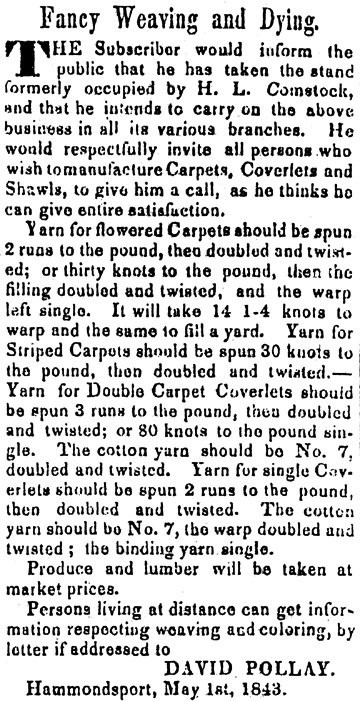
Three identical advertisements were printed in 1840 for weavers in Hammondsport. One was for J. Conger & Co., another for J. Van Gordon and another for H. L. Comstock. These identical announcements suggest that someone, perhaps Jonathan Conger was promoting the sale of his looms by licensing weavers.
David Pollay’s advertisement of 1843 announces that he was taking over the business of H. L. Comstock. Comstock had been reading law and went to Canandaigua to become a lawyer. He went on to distinguish himself as a lawyer and judge.
David’s son Frances Conger Pollay who was born in Elmira in 1833 worked at
weaving with his father in Hammondsport. Frances went with Perry to Japan in
1853,
then returned to Pulteney, N.Y. and became a carriage maker. He built a conveyance
for a missionary friend, Jonathan Goble, whose wife was an invalid. Some say
he invented the jinricksha but that is very unlikely that his cart was the
prototype jinricksha in Japan..
David gave up weaving when business declined and with his second son took up carpentry. They built many houses in Hammondsport.
There were a number of weavers in Southport just below Elmira during the 1830s. Among them John Conger and David Pollay, as already mentioned, and J. S. Baker, C. S. Baker, S. G. Stryker, and a person with the last name of Tuttle. The Chemung Historical Society has four coverlets woven for Southport women: Elizabeth Tuthill 1833, Mary Evans 1834, Rebecca Whilhelm, 1836 and Mariah Seely, 1837.
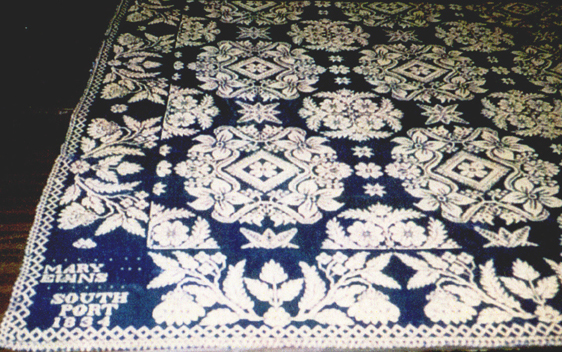
Coverlet woven for Mary Evans, South Port, NY, 1834
Collection of the Chemung Historical Society, Elmira NY, [used by
permission]
Photo by Anne Brewer
1991
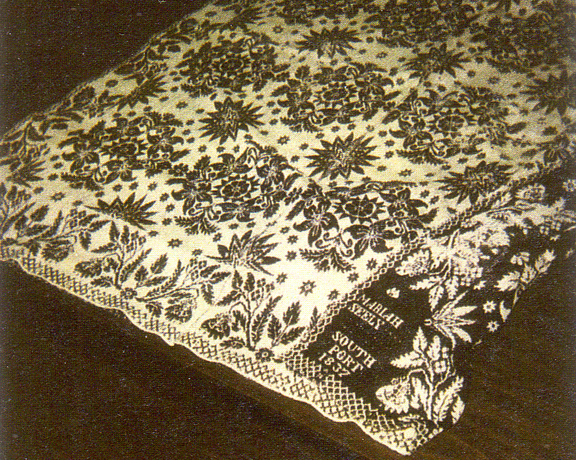
Coverlet woven for Mariah Seeley, South Port, NY, 1837
Collection of the Chemung Historical Society, Elmira NY, [used by
permission]
Photo by Anne
Brewer 1991
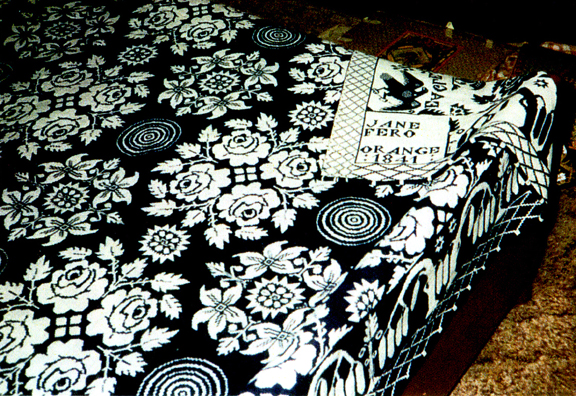
Coverlet woven for Jane Fero, Orange, NY 1841
Coverlet owned by Lois Bauter Van Wormer, Wallace, NY. Photo by Anne Brewer
1993
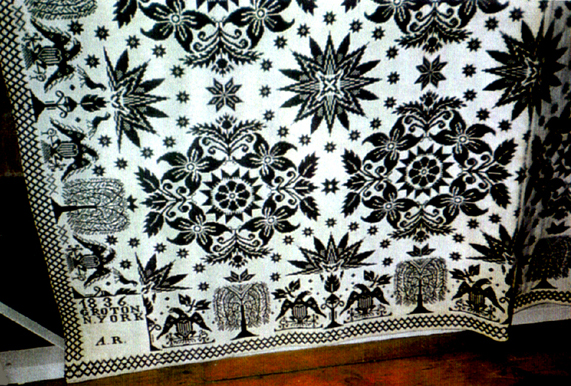
Coverlet woven for A.R., Groton, NY, 1836
Weaver is possibly Jonathan Conger. Photo by Anne Brewer
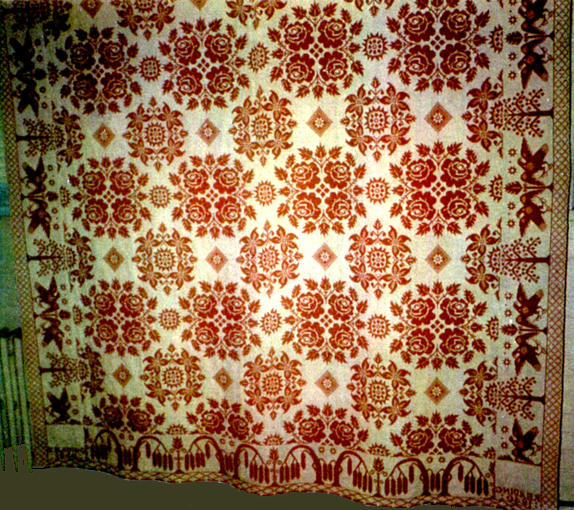
Coverlet woven in Reading, NY in 1840. Now in the Alling Coverlet
Museum,
Palmyra, NY. Photo by Anne Brewer 1992
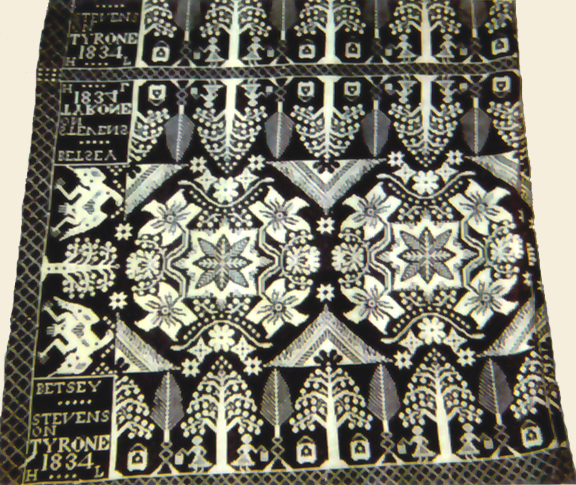
Coverlet woven for Betsey Stevenson, Tyrone, NY, 1834
From the collection of Martha Jack. Photo by
Martha
Jack 2002
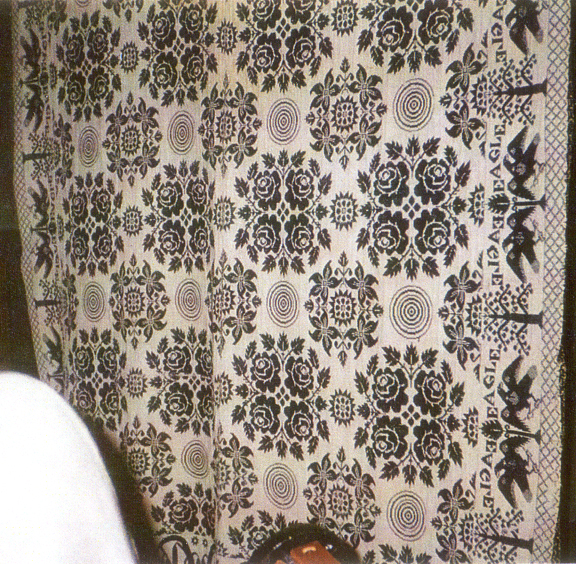
Coverlet woven in Orange, NY
In Alling Coverlet Museum, Palmyra, NY. Photo by Anne Brewer 1992
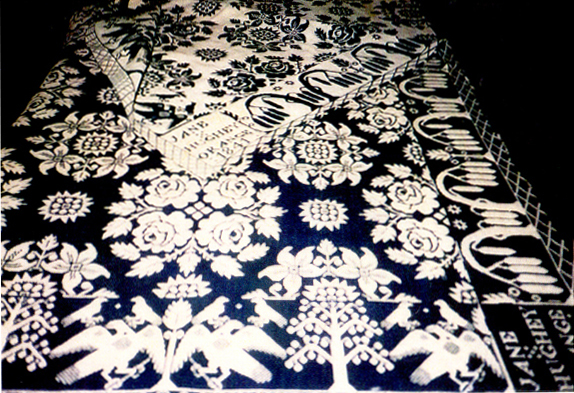
Coverlet woven for Jane Hughey, Orange, NY, 1841
In the Dundee Area Museum, Dundee, NY.. Photo by Anne Brewer 1992
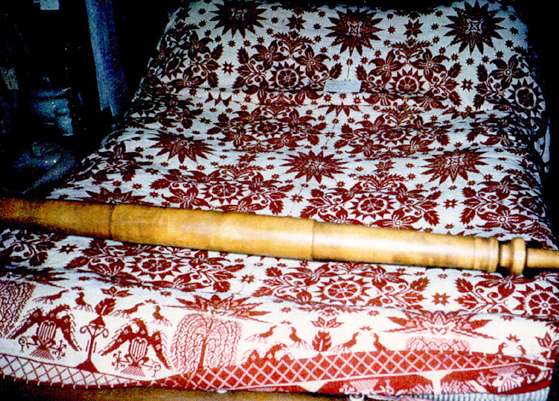
Coverlet woven for Rebecca Secor, Orange, NY, 1831
In the Dundee Area Museum, Dundee, NY. Photo by Anne Brewer 1992
© 2008, by Anne Brewer
The author welcomes questions and information. Please write to her at:
Anne Brewer
1329 Kirkland Village
Bethlehem Pa 18017
|